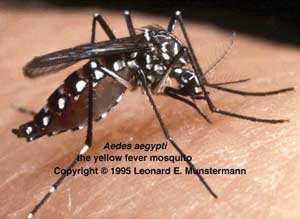Research shows that the development of Dengue fever (DF) has a cyclical pattern. In Vietnam, DF tends to occur in large outbreaks every 3-5 years. The disease occurs year-round but peaks from June to October.
 |
| The main vector for transmitting Dengue fever in Vietnam is the mosquito Aedes Aegypti. (Photo: cober) |
The main vector for transmitting Dengue fever in Vietnam is the Aedes Aegypti mosquito. After feeding on the blood of an infected person, the mosquito can transmit the virus to healthy individuals. This mosquito serves as the disease vector throughout its life cycle, which lasts about a month. It thrives in hot weather and high temperatures.
Pathogenesis
Globally, many hypotheses explain the pathogenesis of DF. In this article, we will present Halstead’s hypothesis, which is widely recognized. Dengue fever commonly occurs in individuals who have pre-existing Dengue antibodies.
When the Dengue virus invades again, it combines with the existing antibodies to form an antibody-antigen complex, known as an immune complex. This complex activates the complement system (one of the body’s defense mechanisms), which increases vascular permeability, disrupts the coagulation system (due to the release of clotting factors), and decreases platelet count, leading to hemorrhage, bleeding, and shock.
Classification of Hemorrhage and Symptoms
Dengue fever is typically classified into four degrees based on the severity of the disease.
Grade I: Fever, lymphadenopathy, body aches, normal pulse, and blood pressure; positive tourniquet test. At this stage, it is very difficult to differentiate from regular fever.
Grade II: Symptoms similar to Grade I accompanied by mild hemorrhaging.
Grade III: Circulatory collapse (rapid, weak pulse), decreased blood pressure, moderate hemorrhage, and pre-shock conditions.
Grade IV: True shock, weak and difficult-to-detect pulse, potentially unmeasurable blood pressure. The incubation period is usually 5-7 days, after which the following symptoms appear:
Viral syndrome: Sudden continuous high fever ranging from 39-40°C, or biphasic fever, loss of appetite, nausea, abdominal pain, headache, muscle pain, peripheral lymphadenopathy, especially in the cervical and elbow regions, and potentially hepatomegaly causing liver pain…
Hemorrhagic syndrome: Includes three types of hemorrhages: Subcutaneous bleeding. Hemorrhagic spots and bruises may occur. Mucosal bleeding: commonly includes symptoms such as nosebleeds and gum bleeding. Internal bleeding: often presents with symptoms like vomiting blood and black stools…
Pre-shock syndrome: Symptoms include confusion, restlessness, cold extremities (especially in the right upper quadrant), excessive vomiting, reduced urination, and decreased blood pressure. This is a dangerous phase that requires close monitoring.
Shock syndrome: Rapid, weak pulse, potentially undetectable. Significant drop in blood pressure; extreme fatigue, cold skin, cyanosis…
Clinical signs (examinations): Increased hematocrit, decreased platelet count.
Treatment
Treatment methods should be based on the classification of hemorrhage severity.
For Grade I and II: Outpatient treatment is recommended to prevent community spread. Careful monitoring is essential to promptly detect signs of pre-shock. The following medications should be used:
– Vitamin C to strengthen blood vessel walls.
– Antipyretics: Paracetamol is commonly used (aspirin should be avoided as it exacerbates bleeding symptoms).
– Fluid replacement: Consume oral rehydration solutions or lemon and orange juice…
For Grade III and IV:
Immediate intravenous administration of electrolyte solutions and colloid solutions is necessary. Commonly used intravenous solutions include 0.9% NaCl, 5% glucose, Ringer’s lactate solution, plasma or plasma substitutes (gelatin dextran…). During the infusion, attention must be paid to the appropriate infusion rate, and it must be monitored by technical staff.
Additionally, cardiovascular support medications, oxygen therapy, and anti-hemorrhagic drugs should be administered. If the patient has significant bleeding, fresh blood, platelet concentrates, and plasma should be transfused.
Prevention
To effectively prevent the disease, it is essential to enhance public awareness so that individuals can take effective preventive measures. In conditions of poor sanitation, hot weather, heavy rainfall, densely populated communities, and extensive economic and cultural exchanges between regions, the development rate of Aedes Aegypti mosquitoes continues to rise, leading to higher disease incidence.
Effective preventive measures include limiting mosquito breeding through:
Mechanical methods: Use mosquito nets, regularly clean water storage containers, maintain hygiene in the surrounding environment, and sleep under a mosquito net.
Biological methods: Introduce fish to eliminate mosquito larvae.
Chemical methods: Spray insecticides…
In addition, close monitoring of fever cases and isolation of Dengue fever patients is crucial.
Currently, the government has implemented policies to support the prevention and treatment of Dengue fever. Therefore, individuals and localities are obliged to promptly report cases of infection to relevant organizations to prevent widespread outbreaks.




















































